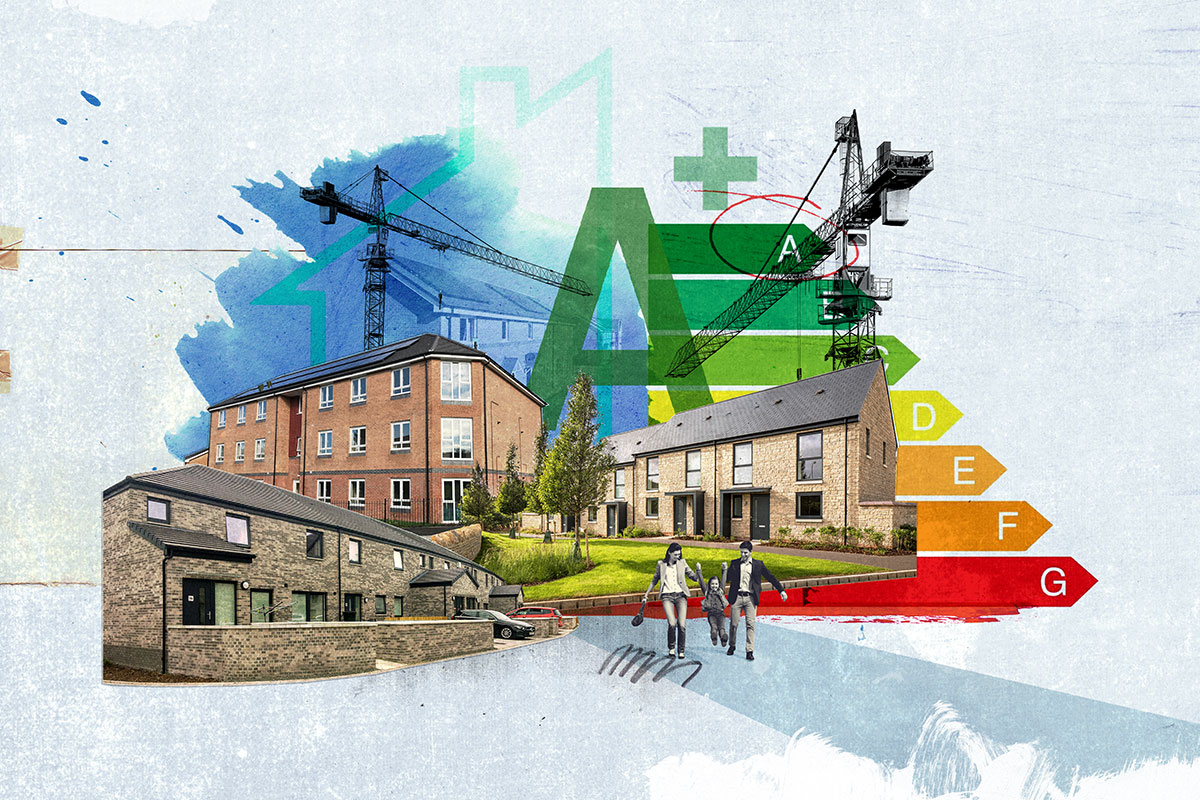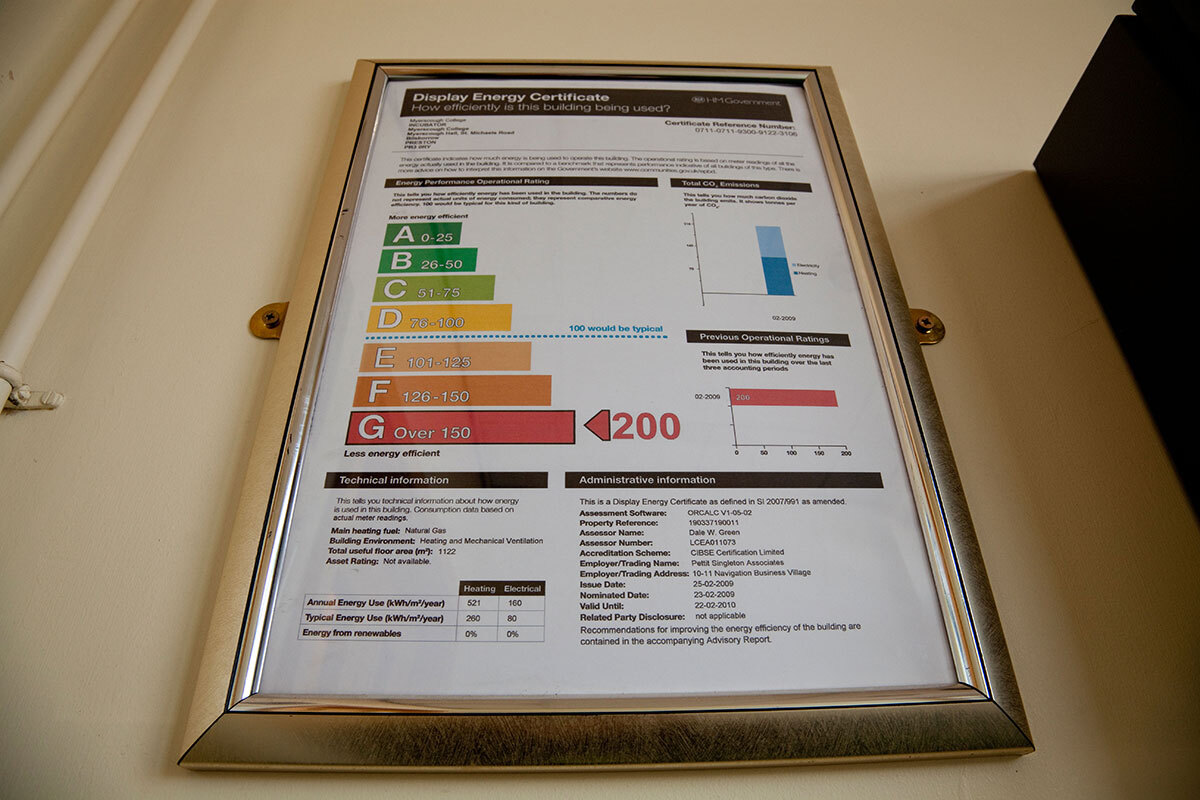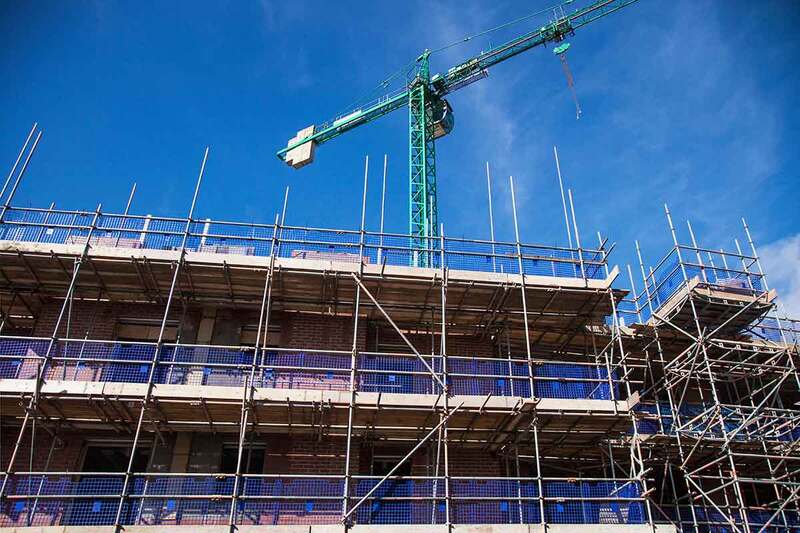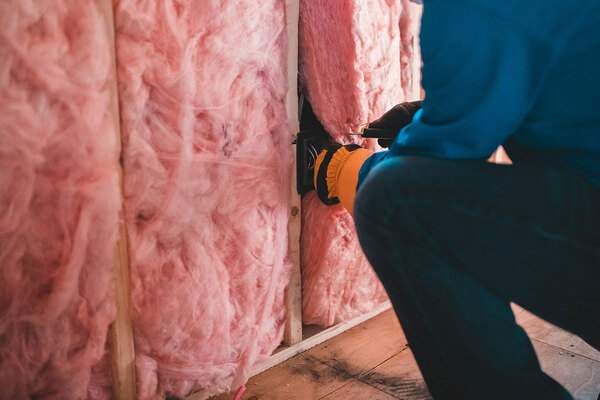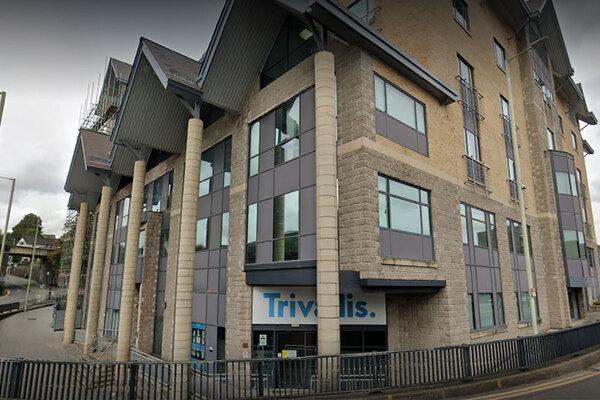How many energy-efficient homes are housing associations building?
Which housing associations are building the most energy-efficient homes? And why, as residents face soaring energy bills, are the number of A-rated energy-efficient homes they build actually dropping? Jess McCabe reveals Inside Housing’s exclusive data and explores what is happening. Illustration by Sarah Hanson
Housing associations have built only a tiny number of homes that have the highest Energy Performance Certificate (EPC) rating of Band A, Inside Housing can reveal. The biggest 157 associations in the UK completed just under 50,000 homes in the 2021-22 financial year, but only 607 homes – 1.2% – achieved an EPC rating of Band A.
The number of energy-efficient homes being completed by associations has actually fallen since last year, when they built 651 Band A-rated properties (representing 1.5% of total completions). The data was supplied to Inside Housing by associations’ development teams as part of our annual Biggest Builders survey.
Our data also shows that social landlords are falling behind the wider building sector: 2% of all new builds in England and Wales were EPC Band A in the latest data. Although that rate is low, it is still more than 40% higher a proportion than housing associations.
Inside Housing decided to track this data to see how social landlords’ development programmes are lining up to deliver the kind of low-carbon homes that will be needed as the UK completes the zero-carbon transition. You would not expect these homes to require retrofitting with better insulation or low-carbon heating and power systems such as heat pumps or solar panels. This year, the significance of the type of homes social landlords are building is particularly stark because of the cost of living crisis and sky-rocketing energy prices.
“When I speak to a lot of people [in the sector], they’re slowly getting the idea that if you spend a little bit more money now on an EPC A-rated home, you save a lot of money on refurbishment”
The difference in cost for a resident depending on the EPC band will be considerable. A resident of a B-rated home – which is what housing associations are largely building – might have spent £500 last year on their energy bills, while their neighbour in an A-rated property probably spent about £200. However, rising energy prices due to the current gas shortage have doubled the difference. So someone living in an EPC Band B home is likely spending about £600 more than if their home had been built to EPC Band A. This is based on estimates by sustainability consultant Richard Lupo.
Reacting to the drop in A-rated homes, Mr Lupo, who is managing director of SHIFT Environment, says: “I’m surprised because there’s such a good business case for building EPC A [homes] right now.”
He adds: “When I speak to a lot of people [in the sector], they’re slowly getting the idea that if you spend a little bit more money now on an EPC A-rated home, you save a lot of money on refurbishment.”
Works such as installing low-carbon heating systems and extra insulation cost more as a refurbishment project than it would to add at new build stage, not least because retrofit work is subject to VAT.
“Higher energy-efficiency standards have clear benefits for tenants and landlords, and we would like to see this become the norm across the construction sector”
Mr Lupo puts this down to “inertia on the concept of spending more money”, especially at a time of cost inflation for building materials.
“It does make it harder to go to the board to say you need £10k or £20k extra per home,” Mr Lupo concedes. But, he says, boards should realise that it saves money to do it at this point rather than as a retrofit project a few years down the line.
So who is – and who is not – building A-rated homes? A2Dominion built the most Band A homes of any association in the UK, completing 72.
Which housing associations built homes rated EPC Band A in 2021-22 and how many they built
| Housing association | Number of new homes completed in 2021-22 | How many were built to EPC Band A? |
| A2Dominion | 893 | 72 |
| Tai Tarian | 61 | 61 |
| Rooftop Housing Group | 116 | 60 |
| Wheatley Group | 438 | 57 |
| Stonewater | 836 | 43 |
| Flagship Group | 655 | 39 |
| Pobl | 363 | 33 |
| Platform Housing Group | 1,171 | 30 |
| Sovereign | 1,196 | 25 |
| BPHA | 307 | 22 |
| Vivid | 1,401 | 17 |
| Wales & West Housing | 347 | 14 |
| PA Housing | 317 | 13 |
| Accent | 248 | 12 |
| Abri | 850 | 10 |
| Gentoo | 258 | 10 |
| Together Housing | 231 | 10 |
| United Welsh | 100 | 10 |
| CHP | 288 | 9 |
| Grand Union Housing Group | 308 | 8 |
| Nottingham Community Housing Association | 465 | 7 |
| Hillcrest | 329 | 7 |
| Castles and Coasts Housing Association | 52 | 7 |
| Notting Hill Genesis | 1,199 | 6 |
| Westward | 90 | 6 |
| Hightown | 610 | 3 |
| Octavia | 80 | 3 |
| Community Housing | 60 | 3 |
| Magenta Living | 56 | 3 |
| Citizen | 467 | 2 |
| The Guinness Partnership | 410 | 2 |
| Plymouth Community Homes | 91 | 2 |
| Moat | 500 | 1 |
| Total | 14,793 | 607 |
Mike Fisher, head of technical (London) at A2Dominion, says: “Our new build apartment schemes feature fabric-efficient external walls which are almost half a metre thick.
“Added to this, our airtight rating is consistently below 2.5 DAP [design air permeability], combined with electric-only heating and hot water systems.”
Solar PV is also part of the picture, Mr Fisher says. “We look carefully at the cost to our residents, our capital expenditure and operating costs to ensure real value.”
Welsh housing association Tai Tarian, which built 61 homes in 2021-22, all of them EPC Band A, says the difference in cost compared with standard builds is less than £10,000 upfront per property.
“Higher energy-efficiency standards have clear benefits for tenants and landlords, and we would like to see this become the norm across the construction sector,” says Andrew Carey, director of assets at Tai Tarian.
“When the [Code for Sustainable Homes] was withdrawn in 2015, there was no push from central government to ensure sustainability. It fell to social housing providers… to adopt a long-term view regarding the importance of sustainability”
The concept of energy-efficient building goes back to the last century, but initially as a matter of the occasional builder doing an outstanding project. This began to change after New Labour introduced the target that all new homes should be zero carbon by 2016. Although work on this target continued when the Conservative-Liberal Democrat coalition came to power in 2010, it was scrapped in 2015 – less than a year before it was due to come into effect – after lobbying by developers. The government also scrapped the Code for Sustainable Homes, which rated homes on energy efficiency and other factors such as low water use.
Jonathan Layzell, executive director of development at Stonewater, says: “When the code was withdrawn in 2015, there was no push from central government to ensure sustainability. It fell to social housing providers, such as Stonewater, to adopt a long-term view regarding the importance of sustainability – the need for which has become increasingly apparent to tackle issues such as fuel poverty.”
National statistics show that nearly one million homes have been completed in England since 2016. Most of these will have been built to only meet minimum building standards – these do not set a minimum EPC rating for homes.
What is the EPC and how is it calculated?
Energy assessors must carry out analysis of the energy and environmental performance of all new build homes. They use the Standard Assessment Procedure (SAP) to score the home, then depending on that score, the home will be given a rating on the A to G scale. These Energy Performance Certificates (EPCs) are also needed before a home can be rented out or sold.
Confusingly, English building regulations do not actually require new homes to hit a specific SAP score or achieve a certain EPC band. This means that the changes coming to English and Welsh building regulations – the Future Homes Standard – cannot be easily translated into homes reaching a certain SAP score or a certain EPC band.
This policy says that all new homes built from this year should produce 31% lower emissions than previous building standards, and requires a 75% cut by 2025, at which point new homes will also not be able to connect to gas. Scottish proposals would see a 75% cut in emissions by 2030, and all new build homes to be required to use zero-carbon heating systems from 2024. All social housing in Wales is meant to reach EPC Band A by 2030, although the government has not yet set out how this will be achieved.
Although most new homes are now EPC Band B, a significant number perform well below this, and being a new build is not a guarantee of being cheaper to heat or emitting less than an older building. The most recent figures from the Office for National Statistics show that about one in five new homes in England only have a Band C rating, while 3% were D.
Another 3% of new builds only achieved an EPC of E – roughly the same as the average Victorian detached house – while some were even rated F or G.
Policy driving change
We know that policy drives action at housing associations. So it is perhaps no surprise that many of those building at EPC Band A are in Wales, given that the country’s government has said that all social housing, new and old, must meet this challenging level by 2030. The second-biggest builder of A-rated homes in the UK was Tai Tarian.
“The homes built last year were designed a couple of years before the Welsh government reviewed the requirements for all new homes attracting social housing grant to be built to EPC A,” says Mr Carey from the 9,000-home association.
“MMC and net zero carbon are at the top of our list for land-led schemes going forward”
Instead, he says, the decision dates back to 2019, when Tai Tarian decided to become carbon neutral by 2030. The association set a corporate plan which listed sustainable homes as one of its key priorities, along with communities and the planet.
“Throughout these is a commitment to address fuel poverty by reducing energy consumption through the standard of homes, with support and advice to reduce consumption and costs,” Mr Carey explains. “Building new homes to reach EPC Band A standard was an opportunity to achieve this.”
Number of EPC Band A-rated homes built by the sector’s top 10 biggest builders
| Housing association | New homes completed in 2021-22 | New homes completed in 2021-22 that are rated EPC Band A |
| L&Q | 4,154 | n/a |
| Clarion | 2,276 | n/a |
| Places for People | 1,775 | n/a |
| Vivid | 1,401 | 17 |
| Bromford | 1,224 | n/a |
| Notting Hill Genesis | 1,199 | 6 |
| Sovereign | 1,196 | 25 |
| Platform Housing Group | 1,171 | 30 |
| Sanctuary | 1,121 | 0 |
| Riverside | 1,121 | 0 |
| Total | 16,638 | 78 |
Scotland’s Wheatley Group is also high up the list of EPC Band A builders, with roughly 13% of its homes meeting this target. However, Frank McCafferty, group director of repairs and assets at the landlord, notes that all of its projects were rated gold or silver in the Scottish government’s sustainability labelling system. “We take a fabric-first approach to reduce energy demand, prioritising the energy efficiency of the building through high levels of insulation and controlling the indoor environment,” he explains.
Wheatley says it plans to build 12,500 “highly energy-efficient” homes in the next 10 years.
“The majority of our projects, of course, are complying with all standards. And then we are looking at where we can exceed standards”
Across the UK, social landlords clearly do have an eye on the energy efficiency of the new homes they are building. Consider Raven Housing Trust – none of the 129 homes it built in 2021-22 were rated A, but it says: “MMC [modern methods of construction] and net zero carbon are at the top of our list for land-led schemes going forward.”
Yet the 10 housing associations that built the most homes in the sector do show the distance still to travel. They built nearly 17,000 homes in 2021-22, but only 78 homes reached EPC Band A. Two built zero A-rated homes, and another four could provide no information.
Biggest builders
Vivid is one of the top 10 builders that did build Band A homes – 17 out of 1,401. Mike Shepherd, its group development and new business director, states that 99% of the landlord’s new homes reach Band B. “What we’re looking at [is] how much extra does that cost us at construction stage to push that to EPC A or zero carbon. It has to be cheaper to do that at new build stage than it is to go back and retrofit these homes,” he says.
L&Q was the biggest builder in the sector this year: completing more than 4,000 homes in 2021-22. It did not disclose how many, if any, of those homes reached EPC Band A, although it says the average rating was B.
Vicky Savage, group development and sales director at L&Q, says: “The majority of our projects, of course, are complying with all standards. And then we are looking at where we can exceed standards, although we have a number of projects at the moment where we are looking at what can be done to improve energy efficiency.”
She notes her team has a head of sustainability for development projects, who analyses these questions as well as other issues such as waste on construction sites.
Bromford is another top 10 builder that did not disclose any data on how many of its 1,224 completions were at EPC Band A. Martyn Blackman, its chief investment officer calls the issue “a live conversation” at Bromford. “We’re obviously considering how and when we move our standards from a new homes perspective. We’re having some conversations around when do we aspire to hit a net zero target,” he adds.
Bromford listed the average EPC rating of its completions as “unknown”.
Even the biggest builder of EPC Band A homes in the sector – A2Dominion – only built 8% of its homes in 2021-22 to this standard. “We can’t let a good-quality, compliant scheme be overlooked on EPC alone when negotiating our contracts. New compliant buildings are more sustainable than older homes, and regenerating existing estates while increasing mixed-tenure housing supply has many benefits from a social, economic and environmental standpoint,” Mr Fisher explains.
This may sound like sensible realism. But anyone looking long term will surely be questioning how sensible it is for housing associations to still be building homes in the knowledge they will soon need to carry out more work to cut energy use and carbon emissions.
Sign up for our development and finance newsletter
Already have an account? Click here to manage your newsletters
